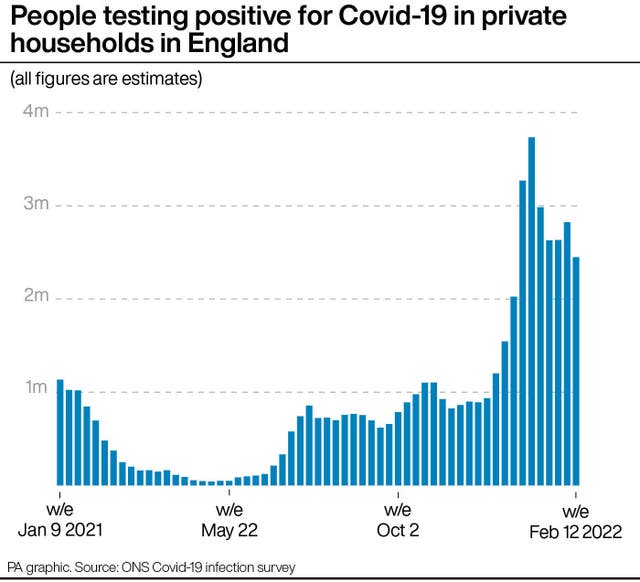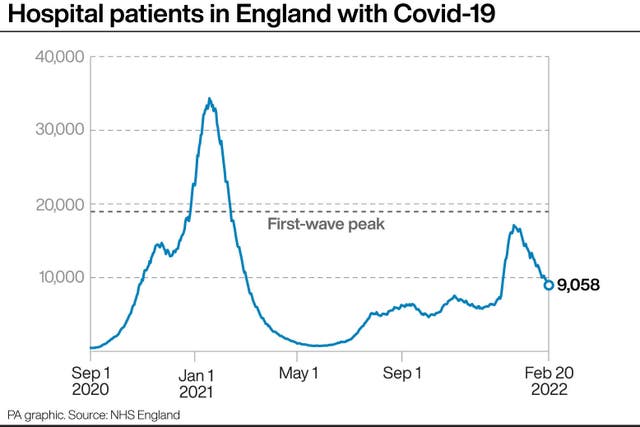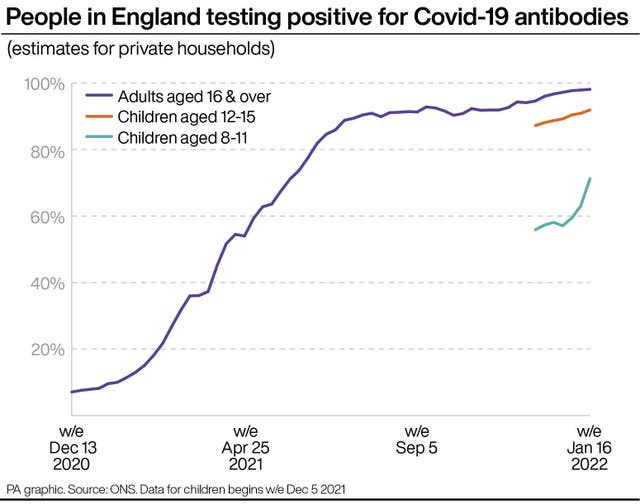Covid-19 in England: what the latest data shows
Here is a snapshot of the latest figures for infections, antibodies, patients and deaths.

Covid-19 infections in England remain higher than before Christmas, but the number of hospital patients and deaths have fallen in recent weeks and continue to be well below levels seen during previous waves of the virus.
As Prime Minister Boris Johnson prepares to announce plans to end all remaining Covid legal restrictions in England, here is an overview of the latest key coronavirus data:
– Infections
Around one in 20 people in private households in England had Covid-19 in the week to February 12, or 2.4 million people, according to estimates from the Office for National Statistics (ONS).
This is down from one in 19, or 2.8 million people, in the week to February 5.
Infections are still higher than they were before Christmas, when the estimate stood at one in 25, or two million people.
But levels have fallen since the peak of the Omicron wave at the start of the year, when a record one in 15 in England had Covid-19 – the equivalent of 3.7 million people.

The ONS infection survey is the most reliable measure of the prevalence of coronavirus across the country.
It is based on a representative sample of swab tests collected from tens of thousands of households, and is therefore able to estimate the percentage of people likely to test positive for Covid-19 at any one point in time – regardless of when they caught the virus, how many times they have had it and whether they have symptoms.
By contrast, the number of cases of Covid-19 announced each day by the Government counts only those people who have reported themselves as testing positive for the virus, and as such is affected by how many people are coming forward for tests or who are taking a test because they know they have coronavirus symptoms.
– Hospital patients
Although infections in England hit a record high during the recent Omicron surge, the number of people in hospital with Covid-19 never came close to matching levels seen in the second wave of the virus a year ago.
Patient numbers reached 17,120 on January 10 2022 – around a half the 34,336 recorded on January 18 2021 at the peak of the second wave, according to NHS England figures.
The total currently stands at 9,058, having fallen by 10% in the past week and down 47% from the Omicron peak.

An estimated 105,600 Covid-19 hospital admissions among people aged 25 and over were prevented in England between December 13 2021 and February 6 2022 due to the “direct effect” of the booster vaccination campaign, according to the UK Health Security Agency.
Just over half of all Covid-19 patients in hospital trusts in England are now being treated primarily for something else, up from a quarter in the autumn of last year.
All patients who have tested positive for Covid-19 need to be treated separately from those who do not have the virus, regardless of whether they are in hospital primarily for Covid or not.
But the growing proportion of patients who are in hospital “with” Covid-19 rather than “for” Covid-19 is another sign that the current wave of the virus has not led to the same sort of pressure on critical care as in previous waves.
– Antibodies
An estimated 98.1% of people aged 16 and over in England were likely to have Covid-19 antibodies in the week ending January 16 2022, according to the ONS.
This is up from 89.4% six months earlier and just 10% in mid-January 2021.
The presence of Covid-19 antibodies suggests someone has had the infection in the past or has been vaccinated.
It takes between two and three weeks after infection – or vaccination – for the human body to make enough antibodies to fight the virus.
Antibodies then remain in the blood at low levels, although these levels can decline over time to the point where tests can no longer detect them.

The latest ONS figure of 98.1% is the highest since estimates began in December 2020 and is likely to reflect both the impact of the vaccination rollout and the high prevalence of Covid-19 in recent months.
Some 91.9% of children in England aged 12 to 15 are also estimated to have antibodies, along with 71.2% of eight to 11-year-olds.
Only a tiny number of children aged eight to 11 outside clinical trials had received any Covid-19 vaccine at the time the estimates were made, meaning almost everyone in this age group with antibodies will have them due to a coronavirus infection.
By contrast, first doses of Covid-19 vaccine have been available for 12 to 15-year-olds in England since September last year, with jabs being offered in schools as well as local vaccination centres.
– Vaccinations
Take-up of Covid-19 vaccines in England has always varied across different age groups and this remains the case in the latest available Government figures.
Around nine in 10 adults aged 70 and over have received at least three doses of vaccine.
The proportion then falls as the age groups get younger.

Take-up of boosters or third doses of vaccine has yet to reach 50% among any group under 40, with the figure estimated to be just 36.3% for 25 to 29-year-olds and 34% for 18 to 24-year-olds.
The very high prevalence of the virus at the start of the year will have meant many people were unable to get an extra jab, as vaccines cannot be given to anybody who has tested positive within the previous 28 days.
But despite infection levels falling in recent weeks, as yet there is no sign that take-up of boosters among young adults is starting to accelerate.
– Deaths
The number of deaths in England where Covid-19 was recorded on the death certificate averaged between 150 and 190 a day during January 2022, according to the ONS.
This is far below the equivalent figures for January 2021, when deaths per day averaged between 800 to 1,200.
While deaths in recent weeks have been higher than much of the second half of last year, the impact of the vaccine rollout is clear.
There has not been the kind of surge in deaths during the Omicron wave that occurred in the first and second waves of Covid-19, despite Omicron being a highly transmissible variant of the virus.

Vaccine effectiveness against mortality with the Omicron variant for people aged 50 and over is estimated to be 95% at two or more weeks after a booster jab, compared with around 60% at 25-plus weeks after a second dose, according to the UK Health Security Agency.
As of January 31 2022, 155,922 deaths had occurred in England where Covid-19 was mentioned on the death certificate, either as the main cause or a contributory factor, the ONS said.
The highest number on a single day was 1,325 on January 19 2021.
During the first wave of the virus, the daily toll peaked at 1,286 on April 8 2020.
Around nine in 10 deaths with Covid-19 on the death certificate since the start of the pandemic have coronavirus as the primary cause of death, with a minority listing the virus as a contributory factor.





